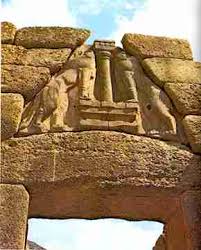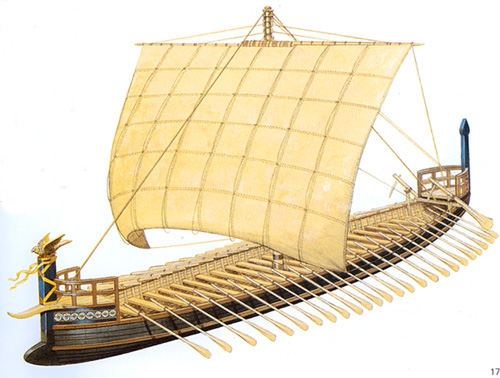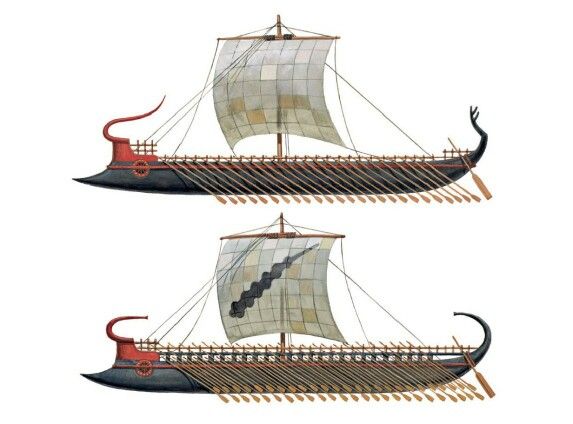In this article we present selected parts from the very informative paper “Analysis and Provenience of Minoan and Mycenaean Amber, III. Kakovatos” by Curt W. Beck, Constance A. Fellows, Audrey B. Adams.

In 1907 Dorpfeld discovered three tholoi at Kakovatos which he equated with Homeric Pylos. This identification has long since been abandoned, but the site retains considerable interest, not least because the amber “spacers” found there invite comparison to those from Germany and England.
The first preliminary report mentions finds only from the largest tholos, later designated as Tholos A, among them “amber which in quantity and variety exceeds anything known so far from Mycenaean tombs. In addition to lentoid beads of various sizes-the largest will have served as sword pommels-there are flat rings with broad loops
for suspension, as well as rectangular plates with multiple drillings.” The tomb was tentatively considered H contemporary with the older tholoi [at Mycenae] which immediately follow the shaft graves [also at Mycenae J.”

In the full report Dorpfeld concluded that the large Tholos A was the most recent, Tholos B slightly older, and Tholos C the oldest, but that all fell into the period of the “second late Minoan style,” to which vases in all three tholoi belong. He based his assignment of relative age in part upon the fact that finds of amber and ivory are much more plentiful in Tholos A, while glass and stone predominate in the other two.
The tholoi are now assigned to LH II A, or 1500-1450 B.C.
(…) All the amber objects from Tholos A are registered in the National Museum of Athens under inventory no. 5688. A large number of beads and some of the more complex objects and fragments have been mounted on a board for exhibition in the Mycenaean Room. The beads have been strung into two necklaces; the first consists of 115 graduated beads of fairly large size ranging from 14mm diameter for the smallest to 42.5mm diameter and 20mm thickness for the largest center bead. Most of the beads are lentoid (in Beck’s classification: Short Convex Bicone, group B.l.e.), though in many the curvature is so slight that they approach a bicone (Beck’s Short Bicone, group B.2.e). A few of the smaller beads are discs, i.e., they have parallel flat sides. Their edges may have been sharper once than they are now and the distinction between Miiller’s “flat plates with rectangular cross-section” (Beck’s Cylinder Discs, group A.2.b or Short Cylinders, group B.2.b) and those with “rounded edges” (Beck’s Barrel Discs, group A.l.b or Short Barrels, group B.1.b) may reflect differences in wear and weathering rather than in intentional, original shape.

The second necklace on the exhibition board consists of 291 smaller beads ranging in diameter from 5.5mm to 18.5mm. Again the larger beads are biconvex or biconical and the smaller ones, almost half of the total number, are discs with sharp or rounded edges.
In a cardboard box in the storeroom at the National Museum there are several hundred fragments, many of which are large enough to be recognizable as having been part of beads, pendants or spacers. To preserve the whole beads, samples were taken from eleven of the fragmentary beads (…) By computer classification, ten of the eleven spectra were identified as those of Baltic amber; the exception, spectrum 1553 of sample 11, differs only minutely from the others but fails to meet the stringent computer test.
(…) The computer, which has “seen” spectra of authentic schraufite, promptly classified the spectra of these four pendant fragments as schraufite. The evidence is suggestive but far from conclusive. It invites the notion that some of the pendants may have been made of fossil resins nearer to hand than the Baltic deposits, which in turn suggests local manufacture. But since the majority of the pendants, as of all the other amber objects in Tholos A, are unquestionably of Baltic amber, such an assignment, even if it is correct, does not alter the fact that Mycenaean Kakovatos participated in the amber trade in the Middle Bronze Age.

(…) The ‘Schieber’ are beads only in the broad sense that they have drill holes for stringing; since their purpose was to separate the strands of a multiple necklace from one another, rather than the beads of a single strand, we call them simply ‘spacers’.
The spacers from Kakovatos are clearly related to similar ones from western and northern Europe. Merhartll first compared them with ten spacers from six tumuli of the South German Tumulus Culture (Hugelgraberkultur) and found them sufficiently alike to conclude, “that the spacers of Kakovatos are imports from the North will remain a certainty even if the amber used to make them should not be Baltic as is commonly assumed.”
Merhart did not extend his view to the amber spacers reported in England by Stukeley, Hoare, Thurnam and others during the past two centuries. Much later, Milojcic considered the newly discovered spacers of Grave 0 in Grace Circle B at Mycenae, which
dates to about 1525 B.C. He acknowledged the implications of these finds to the dating of the South German Tumulus Culture, and he compared them as well to the spacers of the English Wessex culture, but concluded that only those from Lake, Wiltshire, correspond closely, while the rest are “helpless imitations.”
A different view of the relationships between the spacers from Greece, Germany and England has been taken by Hachmann. In an exhaustive investigation, he compared spacers from seven sites in England and forty sites in southern Germany (including Hesse, the middle Rhine, Alsace, Wiirttemberg and Bavaria) with the spacers from Kakovatos and Mycenae, and concluded that the Greek spacers derive from England rather than from South Germany and that the earliest Greek spacers are substantially older than the oldest datable spacers in southern Germany.

The first conclusion is subject to some restrictions: Hachmann himself points out that the spacers from Kakovatos and Mycenae correspond closely not only to some spacers from England (Upton Lovell, Oakley Down, and Huntiscarth (Knowes of Trotty), but also quite as closely to some South German spacers (HundersingenWeidenhang, Mehrstetten, Melchingen-Hakenrain, UpflamorLautrieb, and Wilsingen-Stockacker). The spacer from Koblach, Vorarlberg, Austria, should be included in this group. Hachmann’s relative dating of the German spacers is of necessity limited and vague. As Miss Sandars has pointed out, the fact that the first appearance of such spacers in Greece must now be dated to 1600 B.C. or even earlier does not make it necessary to try to date the German specimens to an equally early period; the evidence as reviewed recently by Professor Piggott shows “that Aegean, and largely Mycenaean, interest in the west and northwest was not an episode of short duration, but something continuous throughout the whole of the Late Helladic period.”
Seen as a whole the distribution of these spacers supports a view of Mycenaean connections with the north of Europe which is now gaining ground : sea-traffic from Greece to the western Mediterranean, whence an overland route along the Rhone-Rhine valleys leads to England and Scandinavia. The South German spacers then could have emanated from Alsace eastwards ; although a separate (and possibly later) connection between Jutland and southern Germany is an alternative possibility that may help to solve the problems in the chronology of the German spacers.
But the evidence for a land route across eastern Europe is by no means negligible. Finds of Mycenaean origin or affinity, as summarized most recently by Sulimirski, leave little doubt that there was a lively traffic between the Aegean and the Danube Basin between the eighteenth and thirteenth centuries B.C. Whether the concentration of such finds in Denmark during this period is necessarily a direct extension of this thrust remains a question to which Sulimirski’s map gives no clear answer. But it would be most unreasonable to deny that some exchange will likely have taken place across the narrow and well-populated gap which remains between central Europe and Jutland.
The choice between a western sea route and an eastern land route is therefore one it might be wiser to reject than to make. There is no reason why the two should be mutually exclusive. There is an analogy to such a solution in Hencken’s compelling analysis of the distribution of the Herzsprung shields oflater times. He showed that the V-type shields spread from the Aegean by a western sea route via Spain to Ireland, while the U-type shields traveled by an overland route from the head of the Adriatic to Denmark and thence to Ireland. This overland route is, of course, the main Iron Age amber route; Navarro has shown that it was of little if any consequence until about 1000 B.C., and thus it cannot be drawn upon to map the Mycenaean amber trade.
(…) Whether the two routes were entirely synchronous, overlapped, or succeeded each other is a question which would merit further examination. It is tempting to hope that the problems which have arisen from the amber spacers found in France, South Germany, Austria and Bohemia could be much reduced by considering that some of
them may be offshoots of the western route while others emanate from the eastern one.

(…) Of the 59 samples of amber from the tholoi of Kakovatos, 46 have been identified as Baltic amber, five (spectra 1570, 1571, 1575, 1576 and 1519) may be schraufite of Balkan or eastern Mediterranean origin, and eight are unidentifiable because of extensive deterioration, though three of these are so similar to spectra of Baltic amber that -their failure to pass the computer test is not significant. This establishes that at least the raw material of most if not all of the amber from Kakovatos must have been imported. The amber can only have come from northern Europe, since the number and size rules out southern Russia, where occasional pieces of Baltic amber occur naturally. Our findings thus agree with those of Jonas, who had analyzed one of the Kakovatos beads by an indirect and questionable adaptation of the succinic acid test.
Research-Selection: Philaretus Homerides
